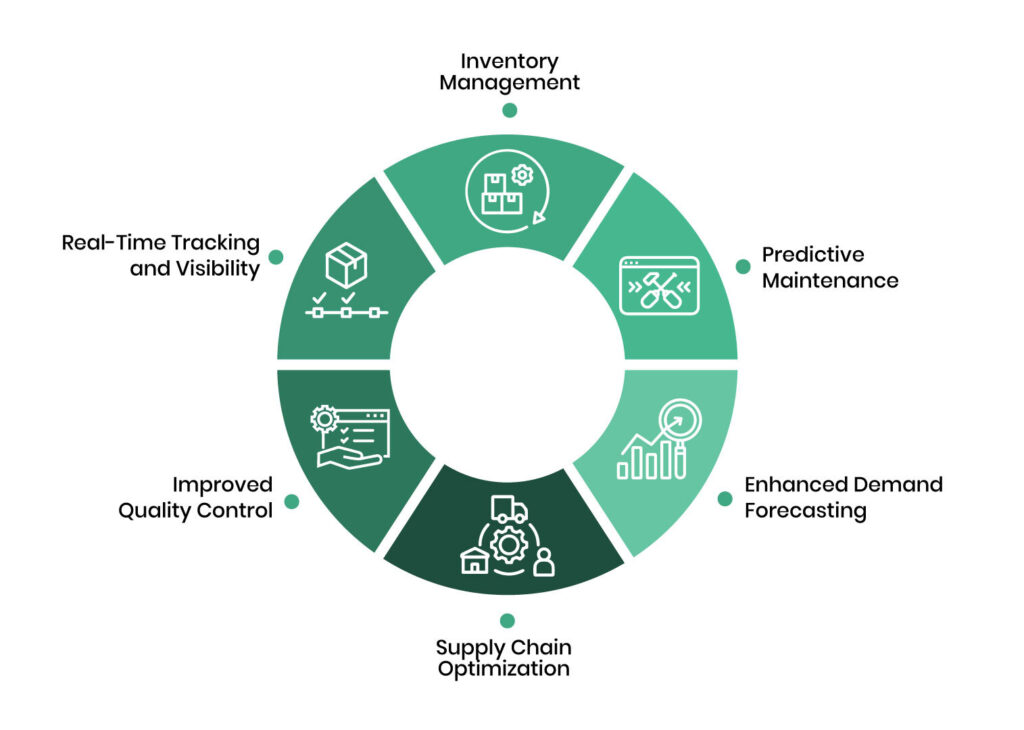Ready to level up your supply chain? IoT is bringing next-level efficiency, real-time tracking, and epic insights that make managing your goods a breeze.
See here how this tech is transforming the game
In today’s fast-paced business environment, supply chain management is more critical than ever. Companies face constant pressure to enhance efficiency, reduce costs, and improve transparency. Enter the Internet of Things (IoT)—a technology that is revolutionizing how supply chains operate. By seamlessly connecting physical assets with the digital world, IoT provides unprecedented insights into supply chain processes, leading to more informed decisions and streamlined operations. This interconnected ecosystem empowers organizations to achieve new levels of visibility, efficiency, and responsiveness, aligning perfectly with global trends towards resilience and sustainability. As industries grapple with increasing complexity and customer expectations, IoT emerges as a crucial enabler for building agile, data-driven supply chains capable of adapting to disruptions and seizing new opportunities
Mastering Supply Chain Optimization: Key Factors for Success
Supply chain optimization is a critical component of modern business strategy, designed to enhance efficiency, reduce costs, and improve overall performance. As companies face increasingly complex and dynamic market conditions, optimizing their supply chains has become essential for maintaining a competitive edge. Several key factors influence supply chain optimization, each contributing to the ability of businesses to streamline operations and respond effectively to market demands. This essay explores these critical factors, including technological advancements, data analytics, supply chain visibility, process integration, and collaboration.
Technological Advancements
Technological advancements play a pivotal role in supply chain optimization. Innovations such as the Internet of Things (IoT), artificial intelligence (AI), and blockchain technology are revolutionizing how supply chains are managed. IoT devices provide real-time data on inventory levels, shipment locations, and equipment conditions, allowing for more accurate and timely decision-making. AI and machine learning algorithms analyze large volumes of data to forecast demand, optimize routes, and identify inefficiencies. Blockchain technology enhances transparency and traceability by creating immutable records of transactions and movements within the supply chain. Embracing these technologies enables businesses to automate processes, reduce errors, and gain valuable insights into their supply chains.
Data Analytics
Data analytics is another crucial factor influencing supply chain optimization. The ability to collect, analyze, and interpret data from various sources empowers businesses to make informed decisions and optimize their operations. Advanced analytics tools and techniques, such as predictive analytics and prescriptive analytics, help companies forecast demand, manage inventory, and optimize procurement strategies. By leveraging data, businesses can identify patterns, trends, and potential issues before they become significant problems. This proactive approach enables companies to adjust their strategies, minimize disruptions, and enhance overall supply chain performance.
Supply Chain Visibility
Supply chain visibility refers to the ability to track and monitor all elements of the supply chain in real-time. Increased visibility allows businesses to gain insights into every stage of the supply chain, from raw material sourcing to final delivery. Technologies like GPS tracking, RFID tags, and real-time dashboards enhance visibility by providing accurate and up-to-date information on the location and condition of goods. Improved visibility helps businesses respond quickly to disruptions, manage risks, and ensure compliance with regulations. It also facilitates better coordination between different stakeholders, including suppliers, manufacturers, and distributors.
Process Integration
Effective supply chain optimization requires seamless process integration across various functions and departments. Integrating processes such as procurement, production, logistics, and distribution ensures that information flows smoothly and efficiently throughout the supply chain. Enterprise Resource Planning (ERP) systems and Supply Chain Management (SCM) software facilitate this integration by providing a centralized platform for managing and coordinating supply chain activities. Process integration reduces redundancies, enhances collaboration, and improves overall operational efficiency. It also enables businesses to align their supply chain strategies with their broader organizational goals.
Collaboration and Communication
Collaboration and communication among supply chain partners are essential for optimization. A well-coordinated supply chain involves close collaboration between suppliers, manufacturers, distributors, and retailers. Effective communication ensures that all stakeholders are aligned and working towards common objectives. Collaborative approaches, such as Vendor Managed Inventory (VMI) and Collaborative Planning, Forecasting, and Replenishment (CPFR), foster strong relationships and mutual trust between partners. By sharing information, resources, and expertise, supply chain partners can work together to address challenges, optimize processes, and achieve better results.
Risk Management
Risk management is a critical aspect of supply chain optimization. Supply chains are exposed to various risks, including supply disruptions, demand fluctuations, and geopolitical uncertainties. Effective risk management strategies involve identifying potential risks, assessing their impact, and developing contingency plans. Techniques such as scenario planning, risk assessment frameworks, and business continuity planning help businesses prepare for and mitigate the effects of disruptions. By proactively managing risks, companies can minimize the impact of unforeseen events and maintain a resilient and optimized supply chain.
Key Applications of IoT in Supply Chain Management

- Real-Time Tracking and Visibility
IoT enables real-time tracking of goods and assets throughout the supply chain. GPS trackers and RFID tags attached to products or containers provide accurate location data, allowing companies to monitor their shipments’ progress. This visibility helps in preventing theft, loss, and delays, and ensures timely delivery to customers. - Inventory Management
Managing inventory effectively is crucial for maintaining a smooth supply chain. IoT sensors can monitor inventory levels in real-time, providing automatic updates when stock levels are low. This ensures that companies can replenish their inventory promptly, reducing the risk of stockouts or overstocking. - Predictive Maintenance
IoT sensors installed on machinery and equipment can monitor their performance and condition. By analyzing this data, companies can predict when maintenance is needed before a failure occurs. This proactive approach reduces downtime, minimizes repair costs, and extends the lifespan of equipment. - Enhanced Demand Forecasting
IoT data provides valuable insights into consumer behavior and market trends. By analyzing data from various sources, including social media, sales transactions, and environmental factors, companies can improve their demand forecasting accuracy. This helps in optimizing inventory levels, production schedules, and supply chain operations. - Supply Chain Optimization
IoT devices can gather data on various supply chain parameters, such as temperature, humidity, and environmental conditions. This information helps in optimizing the storage and transportation of sensitive goods, such as perishable items or pharmaceuticals, ensuring they are kept within the required conditions. - Improved Quality Control
IoT sensors can monitor product quality throughout the supply chain. For example, temperature sensors in refrigerated containers ensure that perishable goods are kept at the right temperature. If any deviations are detected, immediate actions can be taken to prevent spoilage or quality issues.
How is IoT Transforming Supply Chain Management ?

IoT is revolutionizing supply chain management with a variety of applications. For example, in transportation, IoT-enabled tracking devices optimize routes based on up-to-the-minute traffic information, while predictive maintenance averts costly vehicle breakdowns. Warehouses profit from intelligent inventory management using sensors and unmanned aerial vehicles for efficient order fulfillment. The cold chain is transformed by IoT-enabled smart packaging and constant monitoring of vaccine shipments. Beyond efficiency, IoT drives cost reduction, enhances customer satisfaction, and fosters sustainability. For instance, optimized routes decrease fuel consumption, while predictive maintenance minimizes downtime. Real-time order updates and superior product quality boost customer satisfaction. Furthermore, IoT aids in reducing waste, optimizing resource utilization, and improving supply chain transparency through blockchain technology.
While implementing IoT presents significant benefits, addressing challenges such as data privacy, infrastructure expenses, and skill gaps is crucial. Data security safeguards and adherence to regulations are essential. Cost-effective IoT solutions and long-term return on investment analysis can mitigate infrastructure concerns. Training and developing employee skills are vital for successful IoT adoption. The future of supply chain management lies in the integration of IoT with artificial intelligence, blockchain, and digital twins. AI-driven predictive analytics optimize operations, blockchain ensures transparency, and digital twins enable virtual testing and refinement. By embracing IoT and these emerging technologies, businesses can create more adaptable, resilient, and sustainable supply chains.
Case Summary : Discover how Simelabs revolutionized the dairy supply chain with IoT, delivering impressive results.
Simelabs has partnered with Stellapps to transform the dairy industry’s supply chain through the development of ConTrak. This groundbreaking platform addresses critical challenges such as product spoilage, pilferage, and energy inefficiency in the milk chilling cold chain. By harnessing the power of IoT, ConTrak offers unprecedented visibility into the entire cold chain, from the moment milk leaves the farm until it reaches the consumer. This real-time data empowers Stellapps to optimize milk collection routes, ensuring timely pickup and reducing transportation costs. Additionally, the platform’s ability to monitor equipment performance in real-time enables predictive maintenance, minimizing downtime and extending the life of critical infrastructure.
A cornerstone of ConTrak is its focus on product quality and safety. Through seamless integration with smartAMCU, the platform provides robust protection against pilferage and adulteration. Real-time temperature monitoring and alerts safeguard milk quality, ensuring consumers receive fresh and wholesome products. The impact of ConTrak on Stellapps’ operations has been profound. By optimizing routes, reducing wastage, and enhancing product quality, the platform has delivered significant cost savings and improved operational efficiency. Moreover, the assurance of product safety has strengthened Stellapps’ brand reputation and fostered trust among consumers

This successful collaboration between Simelabs and Stellapps serves as a testament to the transformative potential of IoT in the supply chain. By combining our expertise in IoT with Stellapps’ deep industry knowledge, we have created a solution that not only addresses pressing challenges but also sets a new standard for the dairy industry. As we look ahead, Simelabs is committed to expanding the application of IoT across various sectors. Our goal is to empower businesses with data-driven insights and intelligent automation to optimize their supply chains, reduce costs, and enhance customer satisfaction.
Key Benefits of Stellaps ConTrak:
- Real-time visibility & traceability
- Optimized routes & transportation
- Predictive maintenance &reduced downtime
- Enhanced product quality & safety
- Increased operational efficiency & cost savings
- Strengthened brand reputation & customer trust
